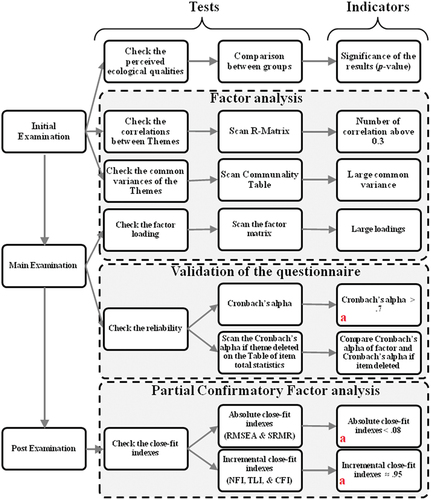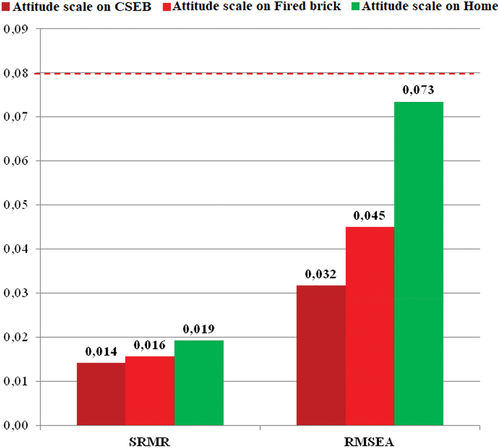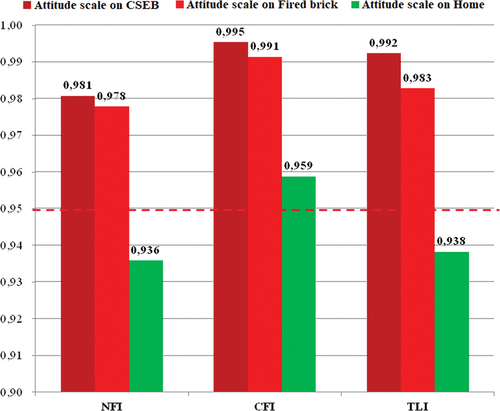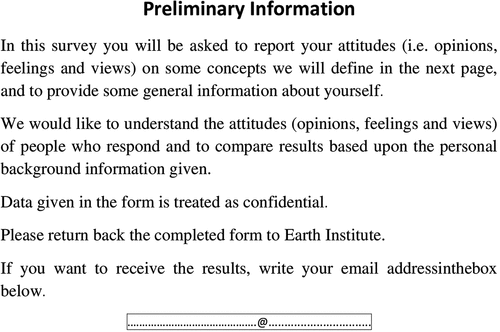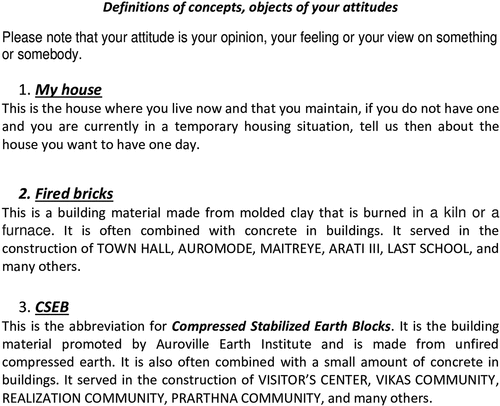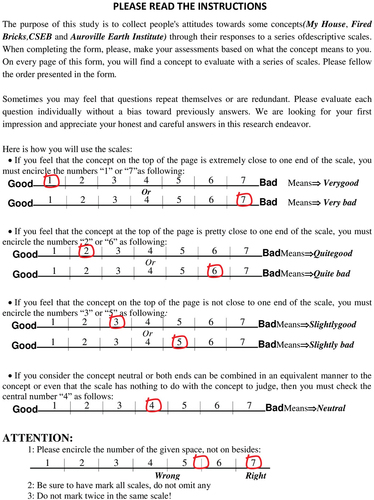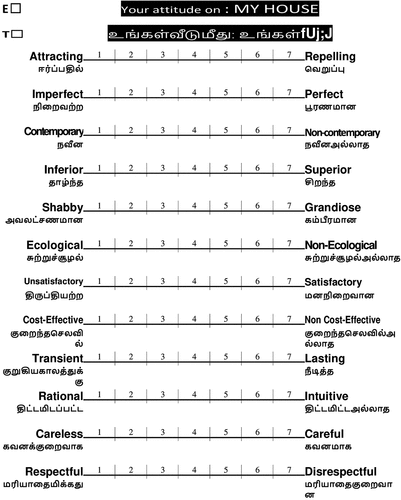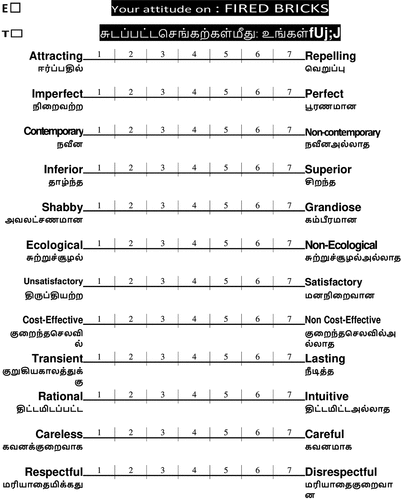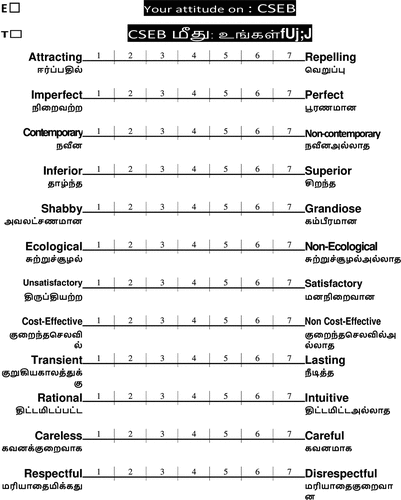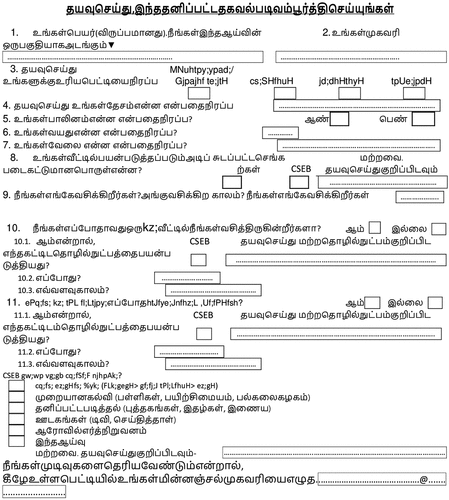ABSTRACT
This study employed exploratory factor analysis (EFA) to assess how perceived ecological quality influences attitudes toward earthen building techniques (EBTs). The aim was to validate scales for measuring attitudes toward compressed stabilized earth blocks (CSEB) and fired bricks in homes. The experimental attitude scales consist of 12 themes, with only 6 themes being selected for measuring attitudes toward CSEBs. Data was collected from Auroville, a city in southern India known for CSEB buildings. Mean values on a 1 to 7 scale showed that CSEB (M = 5.15) and CSEB homes (M = 5.33) were perceived as more ecological (p < 0.01) than fired bricks (M = 3.96) and fired brick homes (M = 4.22). However, EFA results suggested that perceived ecological quality was less important in attitude scales for CSEBs, fired bricks, and homes, warranting its exclusion. The conclusions suggest that education and awareness campaigns that highlight the environmental benefits of EBTs could be used to address the persistent cognitive bias that leads people to perceive fired bricks as neutral. The development of a common scale for assessing attitudes toward EBTs would enable more effective comparisons between different EBTs and the development of targeted promotion strategies. Further confirmatory studies are needed to validate the concept of attitude toward EBTs.
1. Introduction
The importance of attitudes lies in the fact that they are linked to and are even capable of predicting behaviors (Kassin, Fein, and Markus Citation2017, 219), making them the factor that most consistently explains people’s willingness (Chyong et al. Citation2006). Attitude is an interdisciplinary concept. Common attitudes among members of the same community are of great interest in fields such as communication, public affairs, and politics. Understanding attitude is useful because it helps explain: (a) the cause of a person’s behavior toward an object; (b) the consistency of a person’s behavior, which, in turn, helps elucidate social stability; and (c) the way the world is perceived (Oskamp and Schultz Citation2005, 5). The concept of attitude had already been adopted in sociology toward the end of the 1920s and has nourished the debate on both attitude and behavior ever since (Oskamp and Schultz Citation2005, 3). To stress the central importance of attitudes, Gordon Allport, one of the founders of social psychology, wrote: “[The concept of attitude is probably the most distinctive and indispensable concept in contemporary American social psychology…. This useful, one might almost say peaceful, concept has been so widely adopted that it has virtually established itself as the keystone in the edifice of American social psychology. In fact several writers … define social psychology as the scientific study of attitudes]” (Citation1935, 798). Many contemporary scientists agree that this concept is still important in the field of social psychology (Petty and Wegener Citation1998, 323) and will remain so for the foreseeable future (Oskamp and Schultz Citation2005, 3). Attitudes are positive or negative judgments and feelings of people toward the objects surrounding them. They can also be defined as the reactions people have toward a given object (Kassin, Fein, and Markus Citation2017, 211). This comparative study is the first to investigate attitudes toward earthen building techniques (EBTs) involving the use of compressed stabilized earth blocks (CSEB), as well as attitudes toward fired bricks and homes constructed using either fired bricks or CSEB.
EBTs are processes at the base of the production of the built environment, which use raw and graded soil (Hall, Lindsay, and Krayenhoff Citation2012). Houben and Guillaud (Citation1989, 15) inventoried a dozen main EBTs from which more than a hundred variants derive. Considering their minimum cumulative energy demand (Schroeder Citation2016), minimal pollution (Little and Morton Citation2001), and low emission of greenhouse gases Maini and Thautam (Citation2013), these building techniques can be regarded as eco-friendly, which is herein referred as having ecological quality (Houben Citation1994; Luo, Gan, and Ge Citation2014). It is believed that ecological quality can favor a wide use of EBTs (Schroeder Citation2016). Indeed, ASTM E2392/E2392M–10 (ASTM International Citation2016) stresses those that are meant to favor them in the building sector.
To date, very little research has been conducted on understanding the attitude toward EBTs. In the late 1970s, Stewart et al. (Citation1979) (Stewart, Mckown, and Newman Citation1981) and McKown and Stewart (Citation1980) tested the acceptability of earthen dwellings. Studies in the 1980s used marketing methods to make inferences about the acceptability of earthen housing designs (Combs Citation1985; Kay Stewart, McKown, and Newman Citation1981). In 2000 and 2010, surveys on post-occupancy (Kebaili and Bensalem Citation2007; Foruzanmehr Citation2013) and discursive analysis were used to master the perception of the inhabitants. Recently, an Egyptian-Japanese team proved the need for comparing different contexts to better understand attitudes toward earthen dwellings (Hassan et al. Citation2016). The premise that a proper design can reverse trends by causing changes in attitude is common in all these studies (Dahmen Citation2017, 569–574). Other studies focused on particular EBTs with a targeted population, such as residential building contractors (Evan, Rodolfo, and Jonathan Citation2017, 89–107; Kebaili and Kehila Citation2017, 761–772). These studies were conducted in different contexts, which limits their comparative analysis. They manage to identify the positivity or negativity of the attitude but not its attributes toward EBTs. They also recommend ways to prevent the prevalence of negative attitudes. These limits prevent a real capitalization of such research. To overcome the deficiencies observed in previous research, the study herein presented treats the CSEB as a detailed comparative study of an undifferentiated population, aiming to determine a common means of measuring the attitude toward EBTs.
Alastair and Kulshreshtha (Citation2021) showed that the use of EBTs is decreasing worldwide. According to the authors, the world’s population currently living in earthen structures is estimated at between 8 and 10%, whereas before it was estimated at 33% (UNESCO Citation2017). Today many organizations strive to reverse this trend. Motivated by the belief that a better understanding of attitudes toward EBTs will lead to more effective efforts to promote their use, this study proposes survey-based evaluations targeting the populations that are the focus of these efforts.
Furthermore, our motivation is increased by the knowledge that there is no scientific evidence to support the popular hypothesis that EBTs are perceived as more ecologically viable and advantageous than conventional techniques (CTs). Therefore, this study resorts to the methods proposed by environmental psychologists to explore the importance of perceived ecological quality on the approval and attitudes toward different building techniques. An exploratory factor analysis (EFA) of field survey data shows why it is not possible to rely on the perceived ecological quality of EBTs to boost attitudes in their favor and why their currently limited use will persist in the near future. It also shows the important themes that determine attitudes toward EBTs.
The demand for ecological building materials is primarily reflected in the formal adoption by many countries of the sustainable development goals (SDGs), and their urgent embarkment on national development programs (United Nations Citationn.d.), which aim to reduce carbon emissions, greenhouse gases, energy consumption, and waste by 2030 (Ministère de la Transition écologique, n.d). The SDGs constitute an invitation for all organizations and individuals to fight against the negative effects of climate change bv (NBN Citation2019) and adopt pro-environmental behaviors (Oskamp Citation2000). Construction materials and buildings consume a large amount of energy and natural resources (Berge Citation2009, 23; OCDE Citation2003, 22). Thus, using EBTs is a pro-environmental action aligned with the SDGs as it minimizes the negative impact of the building sector on the environment (Kollmuss and Agyeman Citation2002). The adoption of SDGs is the most important demand in favor of EBTs. The UNESCO Citation2010 list of world heritage sites includes 150 properties that have been preserved using EBTs. The purpose of this study was to examine the significance of the ecological qualities of building materials in shaping community attitudes. The following section shows that well-used EBTs are ecologically viable and that their perceived ecological quality is equal to that of CTs considering the attitude of the general population, which may explain the delay in the wide adoption of the former. Subsequently, the study assumes an alternative scenario where the theme of ecological quality is not an important parameter in determining the attitude of the people, making it possible to verify whether people’s attitudes are in line with the SDGs policy.
2. The growing demand for ecological building materials: a global overview
Today, the construction and building industry uses very diverse products. According to their composition, they can be classified into metallic, non-metallic, plant-derived, synthetic, and composite materials. Ecological building materials are materials that generate minimum environmental load and are harmless to human health during raw extraction, product manufacturing, application, and recycling (Luo, Gan, and Ge Citation2014). This section compares the ecological quality of EBTs with that of other CTs and discusses the demand for EBTs. It should be noted that the comparisons are arguments in favor of the promotion of EBTs (Schroeder Citation2016). EBTs have lower intrinsic energy and lesser negative impact on the environment than their conventional counterparts, and are, therefore, a good alternative for building sustainable constructions. (Fernandes et al. Citation2019)
Traditional EBTs are ideal for achieving a lower primary energy intensity value. For instance, rammed earth (1.15 GJ/m2) reduces primary energy intensity to a third compared to fired bricks (3–4 GJ/m2) and to a quarter compared to reinforced concrete (4–10 GJ/m2) (Reddy, Leuzinger, and Sreeram Citation2014). Considering the case of the building sector in India, CSEB structures are considerably less energy-consuming than those built with reinforced concrete or fired bricks (62% and 45%, respectively) (Reddy and Jagadish Citation2003). Similarly, CSEB houses in the US save 35% of the of energy consumption per month compared to similar wooden houses (Shadravan et al. Citation2017). The cumulative energy demanded by CSEB constructions is less than one-sixth of that demanded by fired brick structures (Schroeder Citation2016, 36).
Owing to the limited processing required before reusing them, earthen materials have a remarkable potential to be recovered and incorporated into a new life cycle (Fernandes et al. Citation2019); contrarily, fired bricks exhibit this potential only when connected with the rarely used lime-based mortar (Nordby et al., (Citation2009). At the end of the life of an earthen building, the implementation of EBTs results in the production of reusable earth for construction purposes (Schroeder Citation2016, 520).
Compared to fired bricks, CSEB reduce carbon emissions to one-eighth of their total (Maini and Thautam Citation2013). According to Riza et al. (Citation2010), CSEB generate 22 kg CO2/ton, whereas concrete blocks and fired bricks produce 143 and 200 kg CO2/ton, respectively. In addition, CSEBs reduce CO2 emissions, tropospheric ozone precursor equivalent, and acidification potential by at least half compared to fired bricks (Schroeder Citation2016, 36).
Seventy years ago, Rudofsky (Citation1964) defined EBTs as folk art instruments. Indeed, in the past, stakeholders willing to use EBTs appealed to the development of constructive traditions in the field (Fathy Citation2010; Odul Citation1983). Today, knowledge about EBTs has broadened; in the 1970s, even the United Nations Development Program published regulatory texts about EBTs (Houben and Guillaud Citation1989, 158). Since 1998, the UNESCO Chair of Earthen Architectures has disseminated knowledge pertaining to EBTs in 23 countries (CRATerre Citationn.d.). The International Building Code (IBC), which has been adopted in 15 countries worldwide, contains sections on EBTs (International Code Council Citation2021). Since 1987, the International Union of Laboratories and Experts in Construction Materials, Systems and Structures (RILEM Citation2021), and the International Council for Research and Innovation in Building and Construction CIB (Citation2021) have had technical committees that develop recommendations on EBTs. This folkloric view of EBTs is changing as many specialists all over the world invest in the transition to engineered EBTs. Therefore, the building sector must urgently consider these promising alternatives. Thanks to many international, regional, and national organizations, the demand for EBTs remains strong within the framework of the SDGs. Also, many standard bodies (SB) have responded to this demand by regulating EBTs (cf. ), although the normative corpus continues to be dominated by many standards related to CTs but very few related to EBTs. This battery of existing standards carries the roots of the future development and transition of EBTs from traditional practices to engineering techniques.
Table 1. Standards related to some earthen building materials published by SBs worldwide.
The demand for EBTs at the regional level is illustrated by associations. The Association Voûte Nubienne (AVN) has been active in 5 African countries for more than 20 years popularizing the use of adobe vault (AVN Citationn.d.). Since 2001, the International Association of Natureplus has made efforts to promote sustainable building materials in Europe by issuing ecolabels (Natureplus institute SCE Citationn.d.). Natureplus published guidelines on obtaining the natureplus e.V. label (Schroeder Citation2016, 283). The Earth Building UK and Ireland (EBUKI) association works for the popularization of EBTs in the United Kingdom and Ireland (EBUKI Citationn.d.). The German Federal Environmental Foundation (Deutsche Bundesstiftung Umwelt, DBU) published the “Lehmbau Regeln,” which is a technical document on EBTs under the direction of the German Association for Earthen Construction (Dachverband Lehm Citation2002). At the national level, the 40 members of the UNESCO chair have formed organizations focused on EBTs (CRATerre, Citationn.d.). The Chinese Association Wu Zhi Qiao (WZQCF) launched a project to build 655 earthen villages (World Habitat Award Citation2017). The Earth Building Association of New Zealand contributed to the development of national standards for EBTs (Standards New Zealand Citation1998). Today, six Pritzker Prize winners, namely, Pierre De Meuron and Jacques Herzog (Amàco Citationn.d.), Renzo Piano (RPBW and RPBW and Piano Citation2015), Wang Shu and Lu Wenyu (Ayers Citation2018), and Diébédo Francis Kéré (Kéré Architecture Citation2022) use EBTs in their projects. In 2016, the Terra Awards attracted 357 specialists from all over the world for a wide variety of projects. The International Aga Khan Awards and Riba Awards occasionally highlight EBT projects. Nevertheless, the hidden EBT industry still needs more normative references to flourish (Clement et al. Citation2016).
3. Attitude toward EBTs
3.1. Case study
India is no exception when it comes to the demand for ecological construction with EBTs. The 2011 census indicates that 28.2% of dwellings correspond to earthen buildings. This is among the highest rates in the world, but it is also declining as shown by Y. Kulshreshtha et al. (Citation2020) in their study on the potential and current status of earthen material for low-cost housing in rural India. The Bureau of Indian Standards (BIS) has diligently responded to the demand for EBT regulation, with four standards dealing with many EBT structures published until 2019 (BIS Citation1981, Citation1993, Citation2013), and new normative documents currently under development (BIS Citationn.d.). The Bureau also published the National Building Code of India, which includes two sections concerning EBTs (BIS Citation2016). Additionally, CED 30 is a BIS technical committee specialized in some EBTs, which makes considerable efforts to encourage such construction methods. India is one of the few countries in the world that have their own standards on EBTs, which have inspired the national standards of other countries, like Nepal (cf. ). The Auroville Earth Institute (AVEI) has promoted EBTs since 1989. AVEI is a member of the UNESCO Chair Earthen Architecture. AVEI’s diverse activities are directed toward raising public awareness of and providing short- and long-term training on the restoration of ancient earthen structures, and the design and development of CSEB buildings (AVEI Citationn.d.). AVEI is located in Auroville, Pondicherry, an international township in southern India (see ). Auroville is known for its contributions to several SDGs (Nagy and Szabó Citation2019). It is also famous for its CSEB buildings (Ali and Natarajan Citation2022), notably its visitor center, which was awarded the international Hassan Fathy Prize in 1992. It was founded in 1968 as a city for 50,000 people who would “serve the truth of the Divine Consciousness” and “be a bridge between the past and the future.” The city was designed to be self-sufficient and ecologically conscious, with skyscrapers and electric walkways. Today, Auroville is home to people from nearly 50 countries, and it has become a “new commons on Tamil land (Parker Citation2018). Today, Auroville’s permanent population is approximately 2,200. (Auroville Foundation, 2014), with approximately 5000 natives coming to the city every day for work. Aurovillians are engaged in city policies that encourage clean technologies (Kebaili Citation2016). According to the 2011 census, 28% of all the houses in Auroville are made of earth, which is similar to the national average (Kulshreshtha et al. Citation2020).
Using CSEB is a modern EBT; it is widespread in many countries (Hall, Lindsay, and Krayenhoff Citation2012; Jung Citation2019) thanks to the suitability of many soils for producing CSEB. A number of researchers believe that it is a promising alternative to conventional building materials in many countries (Barbacci Citation2020; Goodhew et al. Citation2019; Gurupatham, Jayasinghe, and Perera Citation2021; Saad et al. Citation2020) especially for housing (Bredenoord and Kulshreshtha Citation2023; Hanafi Citation2021). The quality of raw earth products is very sensitive to the composition of the used earth (Barnaure, Bonnet, and Poullain Citation2021) which is why a soil reconnaissance is done prior to its use. Topsoil and organic soils are avoided. In Auroville, we are used to stabilization with cement and lime; Sandy soils are suitable for cement stabilization. On average, 5% of cement is needed. Clayey soils are suitable for lime stabilization. On average, 6% of lime is needed (AVEI, Citationn.d.). But elsewhere, a number of studies are underway to identify new materials and techniques that can be used to improve the strength and durability of soil without the use of cement or lime such as construction waste, sugarcane bagasse ash combined with wheat straw, rice husk ash, fly ash, and glass waste (Elahi, Shahriar, and Islam Citation2021; Kasinikota and Tripura Citation2021; Malkanthi, Wickramasinghe, and Perera Citation2021; Nshimiyimana, Messan, and Courard Citation2020; Rivera et al. Citation2021; Singh et al. Citation2022; Turco et al. Citation2021; Ubi, Nkra, and Agbor Citation2021). A slightly moistened soil is compressed using a manual or automatic steel press. CSEB may be of different shapes and sizes according to the molds used (AVEI, Citationn.d.). The manual Auram press 3000, commonly employed in Auroville, produces approximately 70 different types of blocks and provides a compressive force of 15 kN (Aureka Citation2021). After 28 days of shade drying, CSEB can be used as regular bricks and joined by cement-stabilized earthen mortar. Buildings made of CSEB are of proven strength and durability (AVEI, Citationn.d.).
3.2. Methodology
The semantic differential (SD) is a reliable method for measuring attitudes (Oskamp and Schultz Citation2005, 44–66). The SD is a simple method that can be repeated from time to time to detect trends in people’s attitudes, to evaluate the interaction between promotional actions and people’s attitudes, and to quantify qualitative material regarding people’s reactions. In addition, SD allows in-depth studies (William, 1961) and can overcome cultural boundaries (Heise Citation1969). It defines attitude as a positive, negative, or neutral evaluation of an object (Osgood and Tannenbaum Citation1955).
The perception of existing buildings’ ecological performance can be assessed using a variety of scientific scales, such as the popular Likert scale (Oskamp and Schultz Citation2005, 51). This scale has been shown to have better construct validity than the SD scale for some purposes (Siegler et al. Citation2020), but the SD scale has other advantages, such as its ability to transcend cultural barriers (Holmberg et al. Citation2021; Oskamp and Schultz Citation2005, 53). This quality makes it a valuable tool for comparing similar studies conducted in different cultures. This is because the SD scale does not rely on formulated sentences, which can be more difficult to translate accurately. As a result, the SD scale is less likely to suffer from meaning loss (Cassin et al. Citation2014; Orago Citation2007) when it is translated into different languages. It is important to note that a study by Friborg et al. (Citation2006) found that both approaches are equivalent and that SD can effectively reduce acquiescence bias. This means that the SD scale can be a valuable tool for assessing the perception of ecological performance in Auroville. The choice of which scale to use should be made based on the specific goals of the study.
In addition to the Likert scale and the SD scale, another method that can be used to assess the perception of ecological performance is the Implicit Association Test (IAT) (Oskamp and Schultz Citation2005, 81). The IAT is a computational tool that can be used to measure unconscious biases. However, the IAT would not be appropriate for use with all populations, such as the Aurovilliens, who may not be familiar with computer tools.
Three SDs were prepared for CSEB, fired brick, and home concepts, each based on 12 adjectival scales, in accordance with the guidelines by Osgood et al. (Citation1957). The 12 adjectival scales were identical for the three concepts. This is important because the method requires the same measuring instrument to allow a comparative study of the three investigated concepts. If, instead, the measuring instruments were different, the comparison would be limited or even inappropriate. Each adjectival scale in the SDs consists of two opposite adjectives at the extremities separated by 7 steps (from 1 to 7) that are used to rank the participant’s inclination toward either of the two opposite adjectives qualifying the concept in question. The concept is clearly marked on the top of the 12 adjectival scales (cf. Annex A).
Osgood et al. (Citation1957) provide a list of adjectival scales that can be used in attitudinal studies. With the help of members of AVEI we chose the eight scales that seemed more appropriate for the study of attitudes toward CSEB, fired bricks, and homes, subsequently adding the following four scales: (1) Shabby – Grandiose, this scale is to find out whether CSEB and CSEB buildings are despised, as explained by Fathy H. in his book The Architecture for the Poor (2010); (2) Ecological – Non-ecological, this scale is to find out whether the building materials and homes are evaluated through their perceived ecological quality, as explained in this paper; (3) Unsatisfactory – Satisfactory, this scale is to measure people’s satisfaction with the homes and building materials, according to the recommendations by ISO 9001 for quality management systems; and (4) Cost-Effective – Non cost-effective, this scale is to find out whether the building materials and homes are evaluated based on their perceived cost-effectiveness (cf. Annex A). In this study, each adjectival scale or theme/item was assigned a distinctive theme title to facilitate its treatment, as shown in .
Table 2. The adjectival scales and their assigned theme titles in the order in which they appear on the questionnaire form.
We limited the SDs to 12 adjectival scales per concept to reduce the response time of the participants. We made a first attempt using 24 adjectival scales per concept, but the time required for filling the form was longer, which could cause people to simply refuse to participate. The number of adjectival scales can be further reduced as will be discussed in the next section. Instructions to correctly fill out the questionnaire form were provided to make it easier for people to participate. A consent form was also attached at the beginning. The personal information of the participants was collected at the end of the form (cf. Annex A). In the following paragraphs, we will indiscriminately talk of the SD of a concept or of an attitude scale on a concept.
The study team prepared a campaign in the local newspaper and on the Institute’s official website promoting voluntary participation. Three investigators roamed the streets of the city during the day to provide forms to volunteers. The surveys were conducted during the summer of 2014. The participation started low, with less than a dozen completed forms per day, then increased to a few dozen per day, and finally reduced back to the starting rate toward the end of the survey period. Our limited means did not allow further data collection. A total of 302 participants were included, and 34 incorrectly filled forms were excluded, with 2% of the forms being collected online. The age of the participants ranged between 13 and 75.
summarizes the steps followed and the indicators used. Two assumptions were verified through an EFA. The first assumption was the equivalence in people’s attitudes toward the ecological quality of CSEB and that of fired bricks. If the ecological quality is perceived as equivalent in people’s attitudes, then actions emphasizing the ecological quality of CSEB made until then can be regarded useless and in need of profound reconsideration. The second assumption was the importance of the ecological quality in determining people’s attitudes toward building materials. If ecological quality is not that important, then this would be a second reason to not emphasize on them. Comparisons were made between means (M) of different attitudes to verify the perceived ecological quality of CSEB. To validate the attitude scales used in this study, the maximum-likelihood estimation (MLE) exploration method ran on the SPSS software was used to infer the importance of the perceived ecological quality in developing people’s scales of attitude. For this research, MLE was used to construct the attitude scale on CSEB and to understand its structure. It also allowed the reduction in the number of themes, because it simplifies the data set to a more manageable size, by retaining as much original information as possible while limiting the attitude scale to important topics only (Field Citation2018). The MLE provides indicators that help decide how important is each theme for the attitude scale. A partial confirmatory factor analysis (PCFA) was subsequently performed to determine if a confirmatory factor analysis (CFA) was worth doing (Gignac Citation2009) and if there was any chance of confirming the used attitude scales. The CFA is needed to confirm the adjectival scales that constitute the attitude scale on EBTs and thus validate the construct (Brown Citation2015) of attitude toward EBTs. Considering the numerous earthen architecture projects around the world, a single means of investigation would be ideal to unite efforts toward a better knowledge and mastery of the attitudes toward EBTs.
3.3. Perceived ecological quality and the attitude scale on CSEB
A thorough examination of the outputs from the MLE highlights the importance of the theme of ecology on the attitude scale on CSEB, based on the guidelines given by Field (Citation2018, chapter 18). Next, we present and examine the reports output by the MLE.
An MLE was conducted on the 12 themes of the CSEB SD with an oblique rotation: direct oblimin with Kaiser’s normalization. The Kaiser – Meyer–Olkin (KMO) measurement estimated at KMO = 0.88 confirmed the adequacy of the sample, placing it in the meritorious level, with no individual KMO value below an acceptable limit of 0.5. An initial analysis was conducted to obtain the eigenvalues for each component of the data. Three factors had eigenvalues above the KMO = 1 criterion, which when combined explained 57.89% of the variance. The graph of the eigenvalues shows one inflection point for factor 4 (cf. ). depicts the theme of ecology as part of the third factor. Only the first factor gives reliable themes, with Cronbach’s α above the reliability threshold of 0.7. Note that Cronbach’s alpha reliability test, the most prevalently employed indicator of scale reliability, is required to validate the attitude scales. Lower values indicate unreliable scales, whereas values of 0.8 indicate highly reliable scales. The threshold value is 0.7. The coefficient of the theme of ecology for the reliable factor individual score is 0.001, and the coefficient of satisfaction is 0.294.
Table 3. Summary of MLE results for the attitude scale on CSEB (N = 302).
An MLE was also conducted on the 12 themes of the fired-brick SD with oblique rotation: direct oblimin with Kaiser’s normalization. The KMO = 0.85 measurement confirmed the adequacy of the sample, which places it on the meritorious level, with no individual KMO value below the acceptable limit of 0.5. An initial analysis was conducted to obtain the eigenvalues for each component of the data. Three factors had eigenvalues above the KMO = 1 criterion, which combined explained 52.8% of the variance. The graph of the eigenvalues shows one inflection point for factor 4 (cf. ). shows the theme of ecology as part of the second factor. Only the first factor gives reliable themes, with Cronbach’s α above the reliability threshold of 0.7. The coefficient of the theme of ecology for the reliable factor individual score is 0.083, and the coefficient of the quality theme is 0.513.
Table 4. Summary of MLE results for the attitude scale on fired-brick (N = 302).
Similarly, an MLE was conducted on the 12 themes of the home SD with oblique rotation: direct oblimin with Kaiser’s normalization. The KMO = 0.84 measurement confirmed the adequacy of the sample, which places it on the meritorious level, with no individual KMO value below the acceptable limit of 0.5. An initial analysis was conducted to obtain the eigenvalues for each factor of the data. Three factors had eigenvalues above the KMO = 1 criterion, which combined explained 54.21% of the variance. The graph of the eigenvalues shows one inflection point for factor 4 (cf. ). shows the theme of ecology as part of the third factor. Only the second factor gives reliable themes, with Cronbach’s α above the reliability threshold of 0.7. The coefficient of the theme of ecology for the reliable factor individual score is 0.015, and the coefficient of satisfaction is 0.27.
Table 5. Summary of MLE results for the attitude scale on home (N = 302).
Finally, an MLE was conducted on the 18 themes of the questionnaire integrating the three SDs after eliminating the unreliable themes. This was done with oblique rotation: direct oblimin with Kaiser’s normalization. The KMO value of 0.84 confirmed the adequacy of the sample, placing it on the meritorious level, with no individual KMO value below the acceptable limit of 0.5. An initial analysis was conducted to obtain the eigenvalues for each factor of the data. Three factors had eigenvalues above the KMO = 1 criterion, which combined explained 52.49% of the variance. The graph of the eigenvalues shows one inflection point for factor 4. shows all factors with Cronbach’s α above the 0.7 reliability threshold.
Table 6. Summary of MLE results for the questionnaire (N = 302).
shows a very little proportion of houses made with CSEB compared to those made of fired bricks. This result resembles the national average recorded in the 2011 census (Kulshreshtha et al. Citation2020). Thus, this result, which may be considered significant with χ2(2) = 200.224 and p < .001, reflects the limited use of CSEB in Auroville. Fired bricks are by far the most widespread building material in Auroville. However, Aurovillians show a wider use of CSEB than other categories of the Auroville population. This is clearly illustrated in , where we can see that 23% of the latter live in houses made with CSEB compared with 7% of volunteers and only 4% of natives. This difference between the different categories of participants is significant with χ2(4) = 48.288 and p < .001.
Figure 3. The predominant building material in Auroville. This is based on participants’ statements. A chi square test was conducted for the difference in the proportion of houses’ type spread in Auroville χ2 (1, N = 272) = 150.01, p < .001, and a statistically significant difference is found.
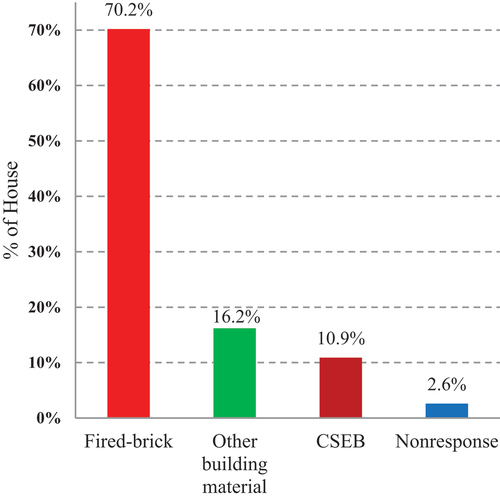
Figure 4. The predominant construction material according to the participant’s status in Auroville. Houses with CSEB are inhabited more by Aurovillians (24) than by natives (5) and volunteers (4). A chi square test was conducted for the difference in the number of inhabitants according to houses’ type and participant’ status in Auroville χ2 (4, N = 294) = 48.29, p < .001, and a statistically significant difference is found.

We present the following results based solely on the scale for the ecological quality of the building materials. As shown in , the first result confirmed the popular notion regarding the ecological quality of EBTs (Fernandes et al. Citation2019). CSEB are perceived as ecologically viable (M = 5.15), which is true for the entire population of Auroville (p < 0.001). However, fired bricks are perceived as neutral (M = 3.96), which is also true for the entire population of Auroville (p < 0.001). These two perceptions are significantly different (p < 0.001) and one can assert with certainty that in Auroville, CSEB perceived as more ecologically viable than fired bricks. Homes in Auroville were perceived as slightly ecological by their inhabitants (M = 4.43, p < 0.05). CSEB houses (M = 5.33), as well as those made of other building materials (M = 4.76) were perceived as slightly ecological. However, fired-brick houses were perceived as neutral (M = 4.22). Once more, these results are true for the entire population of Auroville (p < 0.01). Therefore, one can also assert that in Auroville, CSEB houses are perceived as more ecological than the fired-brick houses (p < 0.01), which invalidates the first hypothesis. The perceived ecological quality of CSEB is not equivalent to that of fired bricks. This questions the importance of ecological quality in the attitude toward CSEB.
Figure 5. The ecological qualities of the studied three concepts; CSEB, houses, and fired-brick as perceived by Auroville population.
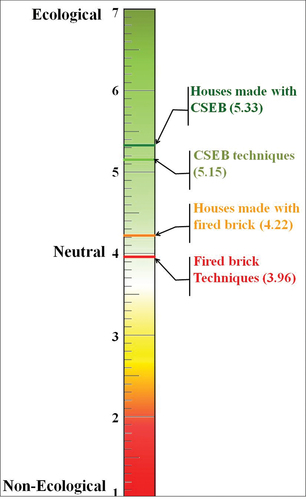
Based on the MLE results, the importance of the perceived ecological quality in attitudes toward the three concepts is presented here. Note that the condition of normality of the distributions of the collected scores does not apply for this study because the interest is in the variables of the questionnaire, which are the themes proposed to evaluate attitudes, such as Satisfaction, Ecology, Standing, etc. (cf. Appendix A). Also, we do not seek to generalize the results on the investigated population, hence, the results are only applicable to the variables/themes studied in the questionnaire.
We assumed that attitudes toward the concepts considered in this study should be measured through the 12 proposed themes. But it is always likely that some themes are related to attitude and others are not. It is therefore reasonable to limit ourselves to themes related to the studied attitudes. The matrices of correlations between the themes of SDs provided by the MLE offer a solution to distinguish important themes. The least correlated themes have the least importance. To reduce the number of themes in the questionnaire, the themes with few correlations above 0.3 with the other themes of the questionnaire are pre-selected. We observe that the theme on ecological quality, referred to as “Ecology”, is among those which fit this criterion. As shown in , this is true for the three concepts studied either (a) separately or (b) together. Considering 3 correlations as very few, the theme of Ecology falls among those that could be eliminated from the questionnaire, including the three scales at this preliminary analysis stage. Between (a) and (b) in , some themes change ranks, but generally, themes with a low number of correlations remain the same and are grouped together separately from themes that have more than 3 correlations above 0.3. In fact, the analysis of the three attitudinal scales highlights the problem of multicollinearity, which emerges because the determinant of the correlation matrix (4 × 10−6) is lower than the threshold (10−5). To correct multicollinearity, we explore each scale separately. The final check done after the elimination of unimportant themes gave a determinant of 0.002. This demonstrates the effectiveness of the procedure. The determinants of the correlation matrices of the three scales no longer exhibit multicollinearity because they are all greater than the threshold of 10−5. They were 0.024, 0.05, and 0.073 for the attitude scales on CSEB, homes, and fired bricks, respectively, before the elimination of unimportant themes and increased to 0.129, 0.146, and 0.269, respectively, after the simplification of the questionnaire.
Figure 6. The ranking of the themes according to the number of correlation coefficient greater than 0.3 per theme. (a) MLE is conducted for each SD separately. (b) MLE is conducted for the questionnaire; the three SDs together. From (a) to (b) the number of correlations increases because some scales from one SD are correlated with others from other SDs of the questionnaire.
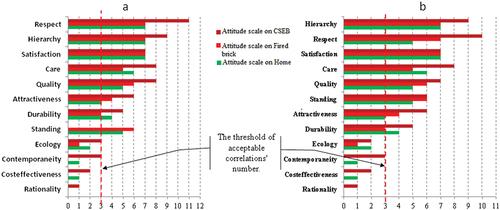
The third indicator of the importance of different themes on the attitude scales of the study is communality. This indicator refers to common variance, that is, the proportion of variance present in a theme and shared with other themes. The higher the communality value associated with a theme, the more important it is. A table of communalities is obtained from the MLE. As shown in , some themes have higher communality values for one attitude scale than for another, as is the case with Contemporaneity, which has a high communality value for the attitude scale on homes but a low communality value for the attitude scale on fired bricks. Also, the theme of Quality has a higher communality value for the attitude scale on fired bricks than for the other attitude scales. The theme of Ecology presents comparable communality values for the three attitude scales, but they are among the lowest. This also reflects the lesser importance of the theme of Ecology on the three attitude scales.
Figure 7. The ranking of the themes according to their values of correlation coefficients with the attitudes.
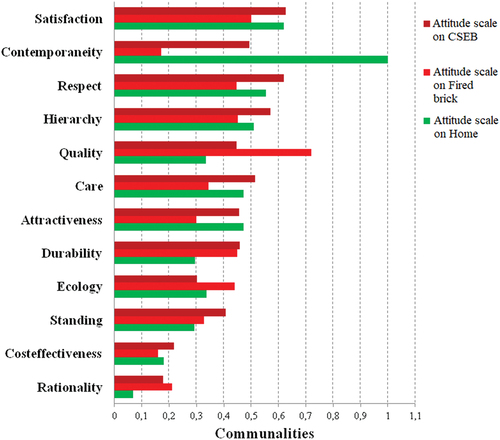
Figure 8. The scree plots. (a) the SD on fired brick. (b) the SD on homes (c) the SD on CSEB. Each plot is organized such that there is one factor for each theme. On the three SDs, the points of inflexion are located on the fourth factor. After the inflection points on each graph, where the abscissa is marked as four, the points align and closely approach the red dashed line. The number of factors to be retained is the number of points before the inflection point. There is some consistency between Kaiser’s criterion (3 factors on each of the ) and the scree plots that justify retaining 3 factors.
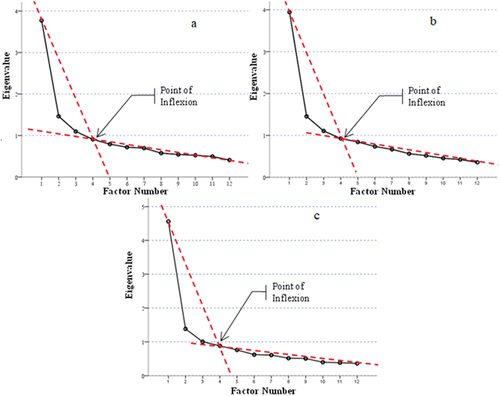
The fourth indicator provided by the MLE is the factor loading, which indicates the relative contribution that each theme makes to an attitude scale. It reflects the importance of the correlation between each theme and the whole attitudinal scale. The higher the loading, the more important the theme. The initial MLE provided three subscales. This makes the interpretation of the loadings difficult. Thus, for this indicator, the MLE was forced to output one factor to compare the loadings of the 12 themes at one time. shows the factor loadings of each of the 12 themes on each attitude scale, with approximately the same values for each attitude scale. The theme of Ecology is one of the themes with the lowest loads for the attitude scales, with all of them being around the 0.3 threshold.
Figure 9. Comparison of the factor loadings. The loads of theme of Ecology are around 0.3. The differences observed in loads are significant only for the themes of Cost-effectiveness, Care, Durability, and Rationality. We can say that the theme of Cost-effectiveness is more important for the attitude toward CSEB than for the attitude toward fired brick (p < 0.001) and the attitude toward home (p < 0.001). The theme of Care is more important for attitude toward CSEB and attitude toward home than for attitude toward fired brick (p < 0.001). The theme of Durability is more important for attitude toward CSEB than for attitude toward fired brick (p < 0.05). Finally the theme of Rationality is more important for the attitude toward CSEB than for attitude toward home (p < 0.05).
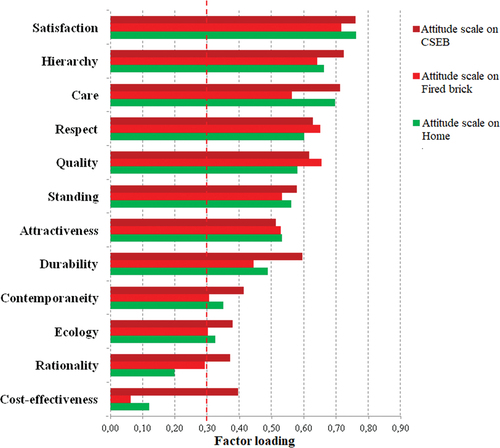
The 3 MLE factor analyses highlighted three latent subscales for each attitude scale (cf. ), It is important to note that the number of factors to be retained is the number of points before the inflection point (Field Citation2018). Each time the theme of Ecology is combined with the theme of Cost-effectiveness to form a subscale of attitude scale. The theme of Respect is combined with them for the attitude scales on CSEB and on home and not for the attitude scale on fired brick. This Ecology subscale: that contains the theme of Ecology, has large correlations with the two other subscales for the attitude scale on CSEB. This is not the case for the two other attitude scales where the subscales of Ecology have small correlations (cf. ). The three subscales are well correlated only for the attitude scale on CSEB.
Figure 10. Comparison between the correlation coefficients of Ecology subscales with the 2 other subscales for the three attitudinal scales. .3 is the threshold of small coefficients.
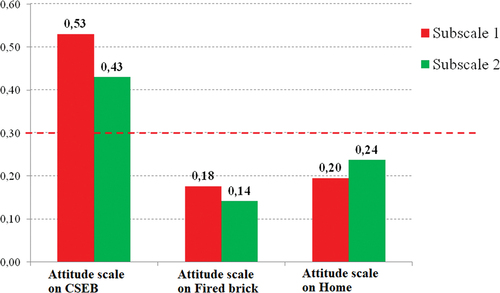
Presently, the validation of attitude scales based on Cronbach’s alpha test will be discussed. As mentioned in the beginning of this subsection, the threshold value for reliable attitude scales is 0.7. The MLE analysis groups the theme of ecology with other themes to create a subscale factor for each of the three SDs under investigation (cf. ). shows that the subscales that encompass the theme of ecology give Cronbach’s alphas below the threshold of 0.7, which means that they are unreliable subscales. The in-depth examination of the correlations between the themes of the reliable subscales shows that the theme of Contemporaneity should be dropped from the fired brick’s attitudinal scale. This later theme is not well correlated with the overall scale with a coefficient of 0.29 which is below 0.3. All the other themes of each subscale are well correlated with the total score of the subscale to which they belong.
Figure 11. Comparison between the results of reliability test. Three subscales have Cronbach’s alpha above the threshold of 0.7.
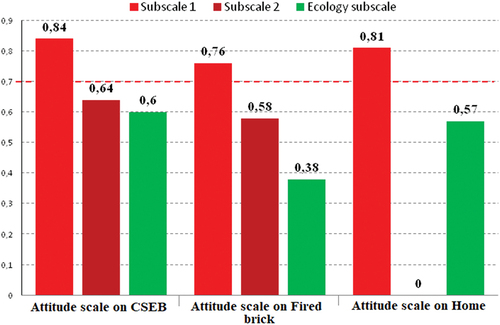
At this point, it becomes clear that the theme of Ecology should be dropped as part of the attitudinal scales related to CSEB, fired brick, and home, and with it all themes forming the unreliable subscales. A final MLE analysis is rerun to check whether the problem of multicollinearity has been resolved. Indeed, the determinant of the correlation matrix is good and is 0.002 which is above the threshold of 10−5. shows the three subscales of the questionnaire. Each subscale is related to one concept; CSEB, Fired brick, and Home. We can be confident then that the questionnaire measures what it was meant to measure namely the three attitudes toward (1) CSEB, (2) Fired brick, and (3) Home.
At the end of this exploratory analysis of validation of the questionnaire on the attitude toward earth-based building technique, it is advisable to present PCFA test results. According to Gignac (Citation2009), five close-fit indexes are needed; two absolute close-fit indexes, the root mean square error of approximation (RMSEA) and the standardized root mean residual (SRMR), values approximating 0.08 to 0.06 or less are indicatives of an acceptable level of model fit, and three incremental close-fit indexes, the normed fit index (NFI), the Tucker – Lewis index (TLI), and the comparative fit index (CFI), values approximating 0.950 or larger are indicatives of an acceptable level of model fit. shows the two absolute close-fit indexes values SRMR, and RMSEA less than the threshold of 0.08. In fact, we do not see any theoretical reason which would lead us to choose one or the other value, 0.06 or 0.08. Therefore, we content ourselves with satisfying the inferiority condition at 0.08. Nevertheless, most of the values remain below 0.06. shows the three incremental close-fit indexes values NFI, TLI, and CFI, which all are approximating and above the threshold of 0.95. This indicates acceptable level of model fit and is very encouraging to carry out a CFA.
4. Discussion and conclusion
As we have just seen, we proposed 12 themes to evaluate people’s attitudes toward CSEB. To provide a single tool for measuring initially different objects and, hence, enable a later comparison between their measurements, the same 12 themes were also proposed for evaluating attitudes toward fired bricks and homes. The MLE method showed that some of these themes were of less importance and, thus, could be removed from the CSEB attitudinal scale. In the case of the fired bricks and homes attitudinal scales, approximately the same themes were of less importance. In particular, ecological quality was one of these less important themes. We were interested in this theme because it is a topical subject. In addition, as shown in section 2, considerable research has been conducted on the ecological quality of CSEB and their suitability. In fact, this result is consistent with those by Chyong et al. (Citation2006) which showed that even people with a great ecological concern do not make pro-environmental actions their first concern. The method used enables stakeholders interested in EBTs to select attitudinal themes that can impact people’s behaviors in the future in a more objective manner. Regardless of how trendy the themes are or if they are on the agenda of the government.
The study proved that CSEB technology is perceived as more ecological than fired bricks in Auroville. We hope that the same will be proven when comparing CSEB with other CTs in Auroville, as well as with all EBTs and other CTs elsewhere. On the contrary, the fired brick technique is still perceived as neutral, neither ecological nor non-ecological in Auroville. If we accept that the fired bricks were commonly used in Auroville before CSEB, then the results can be considered a manifestation of a persistent cognitive bias due to first impressions (Oskamp Citation2000), meaning that a certain initial “neutral” perception of the fired brick technique remains as an anchor that prevents later judgments from shifting to a “non-ecological” perception as suggested by the evidence. This is also true for CSEB houses, which are perceived as more ecological than houses made of fired bricks, which have a neutral perception; this initial neutral perception of fired brick houses is an anchor that prevents a change in judgment on fired bricks despite the evidence that they are less ecological building materials (cf. section 2).
This situation, revealed by the sole Ecological-Non-Ecological scale, could very well be attributed to the positive discourses promoting CSEB and the negative ones against fired bricks, as explained in section 2. The neutral rank of fired bricks as a building material and houses made with them is unexpected. If we refer to the principles of congruity (Osgood and Tannenbaum Citation1955), the pressure exerted by such discourses on fired brick construction is not enough to achieve a non-ecological perception, which we think would favor CSEB. Therefore, the sources of such discourses must be highly ranked on the Ecological-Non-ecological scale. We can make 2 assumptions here: (1) the neutral ranking of fired bricks on the Ecological-Non-ecological scale is fairly resistant to change, and (2) the sources of the negative discourses in relation to fired bricks on the Ecological-Non-ecological scale also rank as neutral on the same scale. In both cases two forces should be evaluated: (a) the resistance of the neutral rank of fired bricks to change, which we can call the intensity of the first impressions persistence, and (b) the minimum pressure needed to trigger the change in this first impressions persistent attitude. What we have just seen about the Ecological-Non-ecological scale also applies to the Cost-effective-Non-cost-effective scale and to other less important scales. Field studies are best carried out through a multidisciplinary approach with the help of architects, sociologists, environmental psychologists, project managers, and other specialists to better understand various aspects of the attitude toward EBTs.
The case of Auroville teaches us that there is a part of the Aurovillian population that shows a preference for the CSEB technique and on which CSEB’s valuating projects can count to encourage its use in the town. This result also prompts the continuation and strengthening of the efforts made so far until they produce a mediation process (Anderson, Lepper, and Ross Citation1980) which could lead to solutions, which include any of the two techniques. But, in the short term, we cannot rely on the theme of ecology to expect a boost in interest for CSEB in Auroville. A thorough knowledge of the Aurovillians will highlight the themes that cause their distinctive inclination toward CSEB. It is on these same distinctive themes that the valuating actions should be based. In his book The Logic of Collective Action: Public Goods and the Theory of Groups, M. Olson (Citation1971) demonstrated that people do not steer their actions in the direction needed without the intervention of external constraints or incentives. Hence, a thorough knowledge of the Aurovillian population should also highlight the constraints and incentives that effectively justify their inclination toward CSEB. Such comparative studies give policymakers the information they need to make decisions that will encourage the use of EBTs.
Only 6 themes were selected to assess the attitude toward CSEB, namely Satisfaction, Standing, Quality, Hierarchy, Durability, and Care. Three common themes could be the base for comparative studies between attitudes toward the 3 studied concepts of CSEB, fired bricks, and homes, namely Satisfaction, Quality, and Hierarchy cf. To return to the list of themes proposed by Osgood et al. (Citation1957), the evaluation scale for the attitude toward CSEB will provisionally group 6 themes selected among the original 12. Alternative themes selected from the adjectival list of Osgood et al. or suggested by other researchers can also be tested. But what we wish is to develop a CFA, which is further encouraged by the favorable PCFA results. Thus, reusing the attitude scale on CSEB to conduct a confirmatory study for validating the construct defined by the 6 important themes herein selected seems feasible. When saying this, we are thinking of the earthen heritage discussed in section 3. A common evaluation scale would be of great interest for capitalizing on the many experiences on earthen construction throughout the world to promote ecological building materials.
Figure 14. The themes selected for the 3 attitudinal scales. These common 3 themes are highly correlated with each other and give Cronbach's alphas > .7. They are .77, .73, and .70 for the attitudinal subscales on CSEB, on fired brick, and on home respectively. The 3 themes provide the foundation for the comparison of the three attitudes.
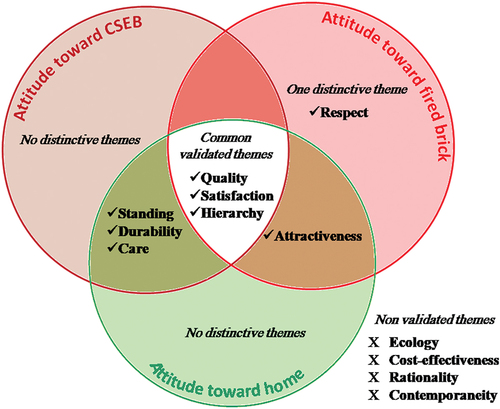
To sum up, this study conducted in Auroville, India, found that CSEB technology was perceived as more ecological than fired bricks which were still perceived as neutral. This is likely due to a persistent cognitive bias caused by first impressions. The study identified six themes used to assess attitudes toward CSEB: satisfaction, standing, quality, hierarchy, durability, and care. Comparative studies between attitudes toward CSEB, fired bricks, and homes could be based on three common themes: satisfaction, quality, and hierarchy. These findings highlight the need for more research on the factors that influence people’s attitudes toward EBTs and more education and awareness about their benefits. The findings could be used to develop more effective strategies for promoting the use of EBTs.
The findings of this study have implications for policy and practice. First, education and awareness campaigns that highlight the environmental benefits of EBTs could be used to address the persistent cognitive bias that leads people to perceive fired bricks as neutral. Second, developing a common evaluation scale for assessing attitudes toward EBTs would enable more effective comparisons between different EBTs and the development of targeted promotion strategies. Finally, continuing research on the factors that influence people’s attitudes toward EBTs would help to identify the most effective ways to promote their adoption and ensure their sustainable use.
Disclosure statement
No potential conflict of interest was reported by the authors.
Additional information
Notes on contributors
Nourredine Kebaili
Nourredine Kebaili is an Assistant Professor at Ammar Telidji University of Laghouat, Algeria. He holds a Magistère degree in Architecture from Ecole Polytechnique d'Architecture et d'Urbanisme of Algiers (2006). His research focuses on attitudes towards earthen architecture in Algeria and worldwide, and he has presented his work at international conferences. Nourredine Kebaili supervises graduate students and collaborates on research projects. He is committed to scientific outreach, participating in public lectures, workshops, and science communication initiatives.
Youcef Kehila
Youcef Kehila is a Professor at the Ecole Polytechnique d'Architecture et d'Urbanisme of Algiers. With a Ph.D. in Geophysics and Geomechanics from the Université Joseph Fourier Grenoble I, France, and a background in Civil Engineering, he specializes in the fields of Environment and Circular Economy, Materials and Eco-construction, and Civil Engineering and Architecture. He is an active member of various scientific committees, has published numerous articles in prestigious journals, and has supervised multiple doctoral and master's theses, as well as research projects.
Rafik Bensalem
Rafik Bensalem is an associate professor at ENSA Toulouse, architect, and Ph.D. holder. With over three decades of experience, his expertise lies in environmental architecture, sustainable urban development, ambiances, and energy efficiency. He has held various institutional positions and supervised several theses. Dr. Bensalem has participated in research projects, international consultations, and cooperation initiatives. He is recognized for his contributions to academia, including teaching and publishing research papers.
References
- Alastair, T. M. M., and Y. Kulshreshtha. 2021. “The State of Earthen Housing Worldwide: How Development Affects Attitudes and Adoption.” Building Research & Information. https://doi.org/10.1080/09613218.2021.1953369.
- Ali, M. F., and M. M. Natarajan. 2022. “Thermal Insulation of Building Envelope for Ecological Conservation.” In Ecological and Health Effects of Building Materials, 185–204. Cham: Springer International Publishing. https://doi.org/10.1007/978-3-030-76073-1_11.
- Allport, G. W. 1935. “Attitudes.” In A Handbook of Social Psychology, edited by C. Murchison, 798–844. Worcester, MA: Clark University Press.
- Amàco. (n.d.). Le plus grand bâtiment d’Europe en pisé : La maison des plantes de Ricola, d’Herzog & De Meuron. Amàco. https://amaco.org/.
- Anderson, C. A., M. R. Lepper, and L. Ross. 1980. “Perseverance of Social Theories: The Role of Explanation in the Persistence of Discredited Information.” Journal of Personality and Social Psychology 39 (6): 1037–1049. https://doi.org/10.1037/h0077720.
- ASTM International. 2016. Standard Guide for Design of Earthen Wall Building Systems: ASTM E2392/E2392—10. West Conshohocken.
- AUREKA. 2021. Aureka. Auram Press 3000. https://aureka.com/.
- AVEI. (n.d.). Auroville Earth Institute. Accessed January 11, 2020, from http://www.earth-auroville.com/.
- AVN. (n.d.). La Voûte Nubienne. Construire autrement en Afrique. Accessed October 31, 2020, from https://www.lavoutenubienne.org/?lang=fr.
- Ayers, A. 2018. Le champ des possibles de Wang Shu et Lu Wenyu AA 426. https://www.larchitecturedaujourdhui.fr/wp-content/uploads/2018/09/AA-426-DOSSIER-_-Portrait.pdf.
- Barbacci, N. 2020. “Earthen Architecture–Valorisation and Underestimation.” The International Archives of the Photogrammetry, Remote Sensing and Spatial Information Sciences. 44:1073–1080. https://doi.org/10.5194/isprs-archives-XLIV-M-1-2020-1073-2020.
- Barnaure, M., S. Bonnet, and P. Poullain. 2021. “Earth Buildings with Local Materials: Assessing the Variability of Properties Measured Using Non-Destructive Methods.” Construction and Building Materials 281:122613. https://doi.org/10.1016/j.conbuildmat.2021.122613.
- Berge, B. 2009. The Ecology of Building Materials. Elsevier. https://doi.org/10.4324/9780080949741.
- BIS. 1981. IS 2110-1980 Code of Practice for in situ Construction of Walls in Buildings with Soil-Cement. BIS. https://www.cracindia.in/admin/uploads/IS-2110.pdf.
- BIS. 1993. IS 13827 Improving Earthquake Resistance of Earthen Buildings—Guidelines. BIS. https://law.resource.org/pub/in/bis/S03/is.13827.1993.pdf.
- BIS. 2013. IS 1725 Stabilized Soil Blocks Used in General Building Construction—Specification. BIS. https://www.services.bis.gov.in:8071/php/BIS/bisconnect/pow/is_details?IDS=NDQ4.
- BIS. 2016. National Building Code of India. NBC: BIS.
- BIS. (n.d.). Bureau of Indian Standards. Documents Under Development. Accessed May 15, 2020, from https://www.services.bis.gov.in:8071/php/BIS/UnderDevDocs/under_dev.
- Bredenoord, J., and Y. Kulshreshtha. 2023. “Compressed Stabilized Earthen Blocks and Their Use in Low-Cost Social Housing.” Sustainability 15 (6): 5295. https://doi.org/10.3390/su15065295.
- Brown, T. A. 2015. Confirmatory Factor Analysis for Applied Research. New York: Guilford publications.
- Cassin, B., E. Apter, J. Lezra, and M. Wood, Eds. 2014. Dictionary of Untranslatables: A Philosophical Lexicon. Princeton University Press.
- Chyong, H. T., G. Phang, H. Hasan, and M. R. Buncha. 2006. “Going Green: A Study of consumers’ Willingness to Pay for Green Products in Kota Kinabalu.” International Journal of Business and Society 7 (2): 40–54.
- CIB. (2021). The History of CIB. International Council for Research and Innovation in Building and Construction. https://cibworld.org/the-history-of-cib/.
- Clement, B., H. Guillaud, A. Clemençon, E. Mille, and J. Le Tiec 2016. Repères historiques de l’architecture en terre, à Lyon et en France, de l’Antiquité à nos jours. Terra Lyon 2016, Acte du XIIe congrès mondial sur les architectures en terre, Jul, Lyon France. 23-29. https://hal.archives-ouvertes.fr/hal-02038203.
- Combs, E. R. 1985. “Home Builders’ Evaluation of Acceptability of Solar and Earth‐Sheltered Housing Designs.” Home Economics Research Journal 14 (1): 143–151. https://doi.org/10.1177/1077727x8501400114.
- CRATerre. (n.d.). CRATerre Chaire UNESCO. Accessed November 27, 2020, from http://craterre.org/enseignement:chaire-unesco/.
- Dachverband Lehm, V. E. 2002. Lehmbau Regeln Begriffe Baustoffe Bauteile. Wiesbaden: Deutsche Bundesstiftung Umwelt.
- Dahmen, J. 2017. “Perceptions of Earth in the Age of Global Architecture.” In Vernacular and Earthen Architecture: Conservation and Sustainability, 569–574. CRC Press. https://doi.org/10.1201/9781315267739-94.
- EBUKI. (n.d.). About Earth Building UK and Ireland. Earth Building UK & Ireland: Fostering the Development of Earth Building. Accessed November 9, 2020, from http://www.ebuki.co/index.htm.
- Elahi, T. E., A. R. Shahriar, and M. S. Islam. 2021. “Engineering Characteristics of Compressed Earth Blocks Stabilized with Cement and Fly Ash.” Construction and Building Materials 277:122367. https://doi.org/10.1016/j.conbuildmat.2021.122367.
- Evan, H., V. V. Rodolfo, and W. E. Jonathan. 2017. “Perceptions of Compressed Earth Block Among Residential Contractors in North Carolina: An Exploratory Evaluation.” Journal of Green Building 12 (4): 89–107. https://doi.org/10.3992/1943-4618.12.4.89.
- Fathy, H. 2010. Architecture for the Poor: An Experiment in Rural Egypt. Chicago and London: University of Chicago press.
- Fernandes, J., M. Peixoto, R. Mateus, and H. Gervásio. 2019. “Life Cycle Analysis of Environmental Impacts of Earthen Materials in the Portuguese Context: Rammed Earth and Compressed Earth Blocks.” Journal of Cleaner Production 241:241. https://doi.org/10.1016/j.jclepro.2019.118286.
- Field, A. 2018. Discovering Statistics Using IBM SPSS Statistics. London: sage.
- Foruzanmehr, A. 2013. “Residents’ Perception of Earthen Dwellings in Iran.” International Journal of Urban Sustainable Development 5 (2): 179–199. https://doi.org/10.1080/19463138.2012.718278.
- Friborg, O., M. Martinussen, and J. H. Rosenvinge. 2006. “Likert-Based Vs. Semantic Differential-Based Scorings of Positive Psychological Constructs: A Psychometric Comparison of Two Versions of a Scale Measuring Resilience.” Personality and Individual Differences 40 (5): 873–884. https://doi.org/10.1016/j.paid.2005.08.015.
- Gignac, G. E. 2009. “Partial Confirmatory Factor Analysis: Described and Illustrated on the NEO–PI–R.” Journal of Personality Assessment 91 (1): 40–47. https://doi.org/10.1080/00223890802484126.
- Goodhew, S., J. Carfrae, K. Hood-Cree, M. Fox, M. Boutouil, and F. Streiff. 2019. “Building with Earth: How We are Working to Revive an Ancient, Sustainable Building Technique.” Construction Research and Innovation 10 (4): 105–108. https://doi.org/10.1080/20450249.2019.1700077.
- Gurupatham, S. V., C. Jayasinghe, and P. Perera. 2021. “Ranking of Walling Materials Using Eco-Efficiency for Tropical Climatic Conditions: A Survey-Based Approach.” Energy and Buildings 253:111503. https://doi.org/10.1016/j.enbuild.2021.111503.
- Hall, M. R., R. Lindsay, and M. Krayenhoff. 2012. Modern Earth Buildings Materials, Engineering, Construction and Applications. Woodhead Publishing Limited. https://doi.org/10.1533/9780857096166.
- Hanafi, W. H. H. 2021. “Compressed Stabilized Earth Block: Environmentally Sustainable Alternative for Villages Housing.” Journal of Engineering and Applied Science 68 (1): 1–13. https://doi.org/10.1186/s44147-021-00017-9.
- Hassan, H., D. Sumiyoshi, A. El-Kotory, T. Arima, and A. Ahmed. 2016. “Measuring People’s Perception Toward Earth-Sheltered Buildings Using Photo-Questionnaire Survey.” Sustainable Cities and Society 26:76–90. https://doi.org/10.1016/j.scs.2016.05.005.
- Heise, D. R. 1969. “Some Methodological Issues in Semantic Differential Research.” Psychological Bulletin 72 (6): 406–422. https://doi.org/10.1037/h0028448.
- Holmberg, C., A. Wolf, C. Eide, F. Großschädl, G. Schüttengruber, H. Patel, and B. Heckemann. 2021. “Classic Tool, New Opportunities: A Psychometric Analysis of a Swedish Online Version of the Aging Semantic Differential Scale.” Research on Aging 43 (9–10): 378–387. https://doi.org/10.1177/0164027520963618.
- Houben, H. 1994. “Ecological and Energy-Saving Advantages and Benefits of Building with Earth.” In Studies in Environmental Science, 941–948. Vol. 60. Elsevier. https://doi.org/10.1016/S0166-1116(08)71527-9.
- Houben, H., and H. Guillaud. 1989. Traité de construction en terre. Marseille: Parenthèses.
- International Code Council. 2021. International Code Council. United States Usage of the I-Codes. https://www.iccsafe.org/international-code-adoptions/.
- Jung, K. Y. 2019. Brief historical review of Earthen Architecture in the World with a focus on Spain and South Korea (Master’s thesis, Universitat Politècnica de Catalunya).
- Kasinikota, P., and D. D. Tripura. 2021. “Evaluation of Compressed Stabilized Earth Block Properties Using Crushed Brick Waste.” Construction and Building Materials 280:122520. https://doi.org/10.1016/j.conbuildmat.2021.122520.
- Kassin, S., S. Fein, and H. R. Markus. 2017. Social Psychology. 10th ed. Boston: Cengage Learning.
- Kay Stewart, K., C. McKown, and J. O. Newman. 1981. “Attitudes of Visitors to an Earth Sheltered Solar House.” Housing and Society 8 (2): 108–117. https://doi.org/10.1080/08882746.1981.11429870.
- Kebaili, N. 2016. “Auroville une ville en avant-garde du développement durable.” Vie de Ville.
- Kebaili, N., and R. Bensalem. 2007. “Etude post occupation d’habitation en terre en Algérie.” CISBAT 2007, Lausanne. EPFL.4-5 September.
- Kebaili, N., and Y. Kehila. 2017. “Attitudes Toward Earthen Architecture: The Case of Compressed and Stabilized Earth Block Architecture in Auroville, India.” WIT Transactions on Ecology and the Environment 226:761–772. https://www.witpress.com/elibrary/wit-transactions-on-ecology-and-the-environment/226/36339.
- Kéré Architecture. 2022. Pritzker Architecture Prize 2022. Kéré Architecture. https://www.kerearchitecture.com/.
- Kollmuss, A., and J. Agyeman. 2002. “Mind the Gap: Why Do People Act Environmentally and What are the Barriers to Pro-Environmental Behavior?” Environmental Education Research 8 (3): 239–260. https://doi.org/10.1080/13504620220145401.
- Kulshreshtha, Y., N. J. Mota, K. S. Jagadish, J. Bredenoord, P. J. Vardon, M. C. van Loosdrecht, and H. M. Jonkers. 2020. “The Potential and Current Status of Earthen Material for Low-Cost Housing in Rural India.” Construction and Building Materials 247:118615. https://doi.org/10.1016/j.conbuildmat.2020.118615.
- Little, B., and T. Morton. 2001. Building with earth in Scotland: Innovative design and sustainability. Great Britain, Scottish Executive: CRU.
- Luo, X. S., C. Gan, and J. R. Ge. 2014. “Application of Ecological Building Materials in the External Layer Design for Building.” In Advanced Materials Research 337–340. Vol. 898. Trans Tech Publications Ltd.
- Maini, S., and V. Thautam. 2013. Embodied Energy of Various Materials and Technologies. AVEI.
- Malkanthi, S. N., W. G. S. Wickramasinghe, and A. A. D. A. J. Perera. 2021. “Use of Construction Waste to Modify Soil Grading for Compressed Stabilized Earth Blocks (CSEB) Production.” Case Studies in Construction Materials 15:e00717. https://doi.org/10.1016/j.cscm.2021.e00717.
- McKown, C. O. R. A., and K. K. Stewart. 1980. “Consumer Attitudes Concerning Construction Features of an Earth-Sheltered Dwelling.” Underground Space; (United States) 4 (5).
- Nagy, B., and Z. Szabó 2019. Introduction to the Green Belt of Auroville: A Detailed Description on How Its Actual Practices Contribute to the UN SDGs. In Proceedings of the Fábos Conference on Landscape and Greenway Planning 6 (1): 27. https://doi.org/10.7275/KJBE-YZ91.
- Natureplus INSTITUTE SCE. (n.d.). “The Founders.” Accessed October 30, 2021. https://natureplus-institute.eu/?page_id=18&lang=en.
- NBN. 2019. ODD 13 : quelles normes soutiennent l’action climatique ?. https://www.nbn.be/fr/l-importance-des-normes-normes-et-objectifs-de-d%C3%A9veloppement-durable/objectif-de-d%C3%A9veloppement.
- Nordby, A. S., B. Berge, F. Hakonsen, and A. G. Hestnes. 2009. “Criteria for Salvageability: The Reuse of Bricks.” Building Research & Information 37 (1): 55–67. https://doi.org/10.1080/09613210802476023.
- Nshimiyimana, P., A. Messan, and L. Courard. 2020. “Physico-Mechanical and Hygro-Thermal Properties of Compressed Earth Blocks Stabilized with Industrial and Agro By-Product Binders.” Materials 13 (17): 3769. https://doi.org/10.3390/ma13173769.
- OCDE. 2003. Pour des bâtiments écologiquement viables, enjeux et politiques. https://read.oecd-ilibrary.org/environment/pour-des-batiments-ecologiquement-viables_9789264034891-fr#page23.
- Odul, P. 1983. L’Architecture de terre en Algérie. Belgique: Project earth construction technologies appropriate to developing countries.
- Olson, M. 1971. The Logic of Collective Action: Public Goods and the Theory of Groups. Cambridge: Harvard University Press.
- Orago, S. O. 2007. Meaning Loss in Literal Translation: A case Study of Dholuo Riddles and Proverbs (Doctoral dissertation, Kenya University).
- Osgood, C. E., G. J. Suci, and P. H. Tannenbaum. 1957. The Measurement of Meaning. Urbana and Chicago: University of Illinois Press.
- Osgood, C. E., and P. H. Tannenbaum. 1955. “The Principle of Congruity in the Prediction of Attitude Change.” Psychological Review 62 (1): 42. https://doi.org/10.1037/h0048153.
- Oskamp, S. 2000. “A Sustainable Future for Humanity? How Can Psychology Help?” American Psychologist 55 (5): 496–508. https://doi.org/10.1037//0003-066X.55.5.496.
- Oskamp, S., and W. Schultz. 2005. Attitudes and Opinions. Lawrence Erlbaum Associates. https://doi.org/10.4324/9781410611963.
- Parker, I. 2018. “Auroville: City of the Dawn, City of the Future, Now.” Teknokultura: Revista de Cultura Digital y Movimientos Sociales 15 (2): 379–386. https://doi.org/10.5209/TEKN.59078.
- Petty, R. E., and D. T. Wegener. 1998. “Attitude Change: Multiple Roles for Persuasion Variables.” In The Handbook of Social Psychology (4th ed ed. Vol. 1 323–390). New York: McGraw-Hill.
- RPBW, and Piano, R. 2015, December 11). Renzo Piano, Centre de chirurgie pédiatrique Emergency (Ouganda). Floornature. https://www.floornature.eu/renzo-piano-centre-de-chirurgie-pediatrique-emergency-ouganda-11203.
- Reddy, V. B. V., and K. S. Jagadish. 2003. “Embodied Energy of Common and Alternative Building Materials and Technologies.” Energy and Buildings 35 (2): 129–137. https://doi.org/10.1016/s0378-7788(01)00141-4.
- Reddy, B. V. V., G. Leuzinger, and V. S. Sreeram. 2014. “Low Embodied Energy Cement Stabilised Rammed Earth Building—A Case Study.” Energy and Buildings 68:541–546. https://doi.org/10.1016/j.enbuild.2013.09.051.
- RILEM. (2021). Active TCs. International Union of Laboratories and Experts in Construction Materials, Systems and Structures. https://www.rilem.net/committees/active-tcs-by-clusters-500209.
- Rivera, J., J. Coelho, R. Silva, T. Miranda, F. Castro, and N. Cristelo. 2021. “Compressed Earth Blocks Stabilized with Glass Waste and Fly Ash Activated with a Recycled Alkaline Cleaning Solution.” Journal of Cleaner Production 284:124783. https://doi.org/10.1016/j.jclepro.2020.124783.
- Riza, F. V., I. Abdul Rahman, and A. M. A. Zaidi 2010. A Brief Review of Compressed Stabilized Earth Brick (CSEB). International Conference on Science and Social Research (CSSR 2010), December 5 - 7, 2010, 999-1004. https://doi.org/10.1109/cssr.2010.5773936
- Rudofsky, B. 1964. Architecture without Architects: an introduction to nonpedigreed architecture. Garden City, NY: The Mesium of Modern Art.
- Saad, A. S., F. M. Al-Enezi, H. A. Al-Sayab, Z. H. Al-Zayed, F. H. Awwad, and S. N. Al-Muhanna. 2020. Compressed Earth Blocks: A Sustainable Construction Alternative. In Gulf Conference on Sustainable Built Environment (pp. 157–168). Springer International Publishing.
- Schroeder, H. 2016. Sustainable Building with Earth. New York, USA: Springer International Publishing.
- Shadravan, S., M. D. Reyes, D. J. Butko, and L. M. Holliday. 2017. Sustainability of Compressed Earth Block Construction: Comparative Analysis of Compressed Stabilized Earth Blocks and Traditional Wood Framed Single Family Residences, 7th Biennial Professional Conference Of The Architectural Engineering Institute, 368–374. https://doi.org/10.1061/9780784480502.030
- Siegler, A. J., S. Wiatrek, F. Mouhanna, K. R. Amico, K. Dominguez, J. Jones, and K. H. Mayer. 2020. “Validation of the HIV Pre-Exposure Prophylaxis Stigma Scale: Performance of Likert and Semantic Differential Scale Versions.” AIDS and Behavior 24 (9): 2637–2649. https://doi.org/10.1007/s10461-020-02820-6.
- Singh, S., J. S. Chohan, R. Kumar, and P. K. Gupta 2022. Stability of Compressed Earth Blocks Using Sugarcane Bagasse Ash and Wheat Straw. Materials Today: Proceedings, 51, 993–997. https://doi.org/10.1016/J.MATPR.2021.07.023.
- Standards New Zealand. 1998. NZS 4297: 1998 Engineering Design of Earth Buildings. Standards New Zealand. https://www.standards.govt.nz/shop/nzs-42971998.
- Stewart, K. K., C. Mckown, and J. O. Newman. 1981. “Attitudes of Visitors to an Earth Sheltered Solar House.” Housing and Society 8 (2): 108–117. https://doi.org/10.1080/08882746.1981.11429870.
- Stewart, K., C. McKown, and C. Peck. 1979. “Consumer Attitudes Concerning an Earth-Sheltered House.” Underground Space;(United Kingdom) 4 (1): 11–15.
- Turco, C., A. C. P. Junior, E. R. Teixeira, and R. Mateus. 2021. “Optimisation of Compressed Earth Blocks (CEBs) Using Natural Origin Materials: A Systematic Literature Review.” Construction and Building Materials 309:125140. https://doi.org/10.1016/j.conbuildmat.2021.125140.
- Ubi, S. E., P. O. Nkra, and R. B. Agbor. 2021. “Stabilization of Earth Block Using Rice Husk Ash as Partial Replacement in Cement.” Current Journal of Applied Science and Technology 40 (12): 12–22. https://doi.org/10.9734/cjast/2021/v40i1231377.
- UNESCO. 2017. Construire la paix dans l’esprit des hommes et des femmes. L’architecture de terre: pour un patrimoine matériel et immatériel respectueux de l’environnement. http://fr.unesco.org/.
- United Nations. (n.d.). Sustainable Development Goals. Goal 13: Take Urgent Action to Combat Climate Change and Its Impacts. Accessed August 16, 2020, from. https://www.un.org/sustainabledevelopment/.
- Wang, L., Y. Zhou, and W. Shi. 2023. “Seismic Response Control of a Nonlinear Tall Building Under Mainshock-Aftershock Sequences Using Semi-Active Tuned Mass Damper.” International Journal of Structural Stability and Dynamics. https://doi.org/10.1142/S0219455423400278.
- World Habitat Award. (2017). World Habitat Awards. Building with Earth. https://world-habitat.org/fr/les-prix-mondiaux-de-lhabitat/vainqueurs-et-finalistes/building-with-earth/.


